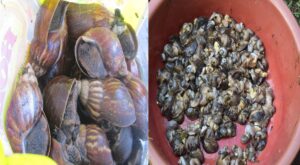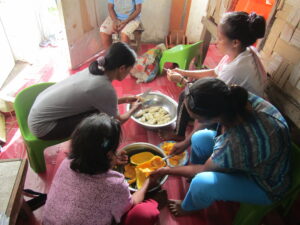In Tanglag, Lubuagan, Kalinga, organic farming has long been practiced but in 2021, synthetic fertilizer such as urea, ammonia and pesticide such as spit fire were introduced. Since then, farmers have observed decreasing production resulting in more application of fertilizer. They have also observed more rice bugs and other pests like army worm and leaf folder.

biruruko or snail is very destructive to vegetables and fruits, it devours almost all plants
In Tabuk, Kalinga, four cavans of urea are needed after transplanting and another four is used as topdressing during its flowering stage. In 2022, the price of urea is at 1,900 per cavan. This means that a farmer needs 15,200 pesos for fertilizer alone in order to grow rice in one hectare.
Due to high cost not only of fertilizer but also of seeds and pesticide, expensive labor and hire of equipment, farmers are struggling to maintain production. Furthermore, hazards such as typhoons, pests, and drought have aggravated low production.
With the above situation, the Cordillera Disaster Response and Development Services Inc (CorDisRDS) through its project Building Resiliency of Indigenous Communities on Climate Change Adaptation (BRICCCA) has conducted sustainable agriculture training focusing on soil and pest management on November 5 and 6, 2022 in Tanglag, Lubuagan.
The sustainable agriculture ladderize course offered by CorDisRDS consists of Soil management, Pest management and palay production improvement.
Sustainable agriculture is a system of agriculture that responds to the need of today’s generation but does not compromise the future. This being said, farming should be environmentally friendly or does not use anything that could harm the environment. Farmers should not rely on materials coming from outside especially bought rather, they should use resources available in the community. Also, the technology should be easy to understand and replicate that even the poorest and oppressed can use.
The output of the two-day training were foliar fertilizers such as fermented fruit juice using ripe papaya and banana, fermented plant juice using banana trunk and water hyacinth, indigenous micro-organism from rice and kohol amino acid using “biruruko” or snails. All these materials are abundant in the community in fact, the water hyacinth and biruruko are considered pests. The water hyacinth depletes oxygen and takes space in lake Bannong affecting tilapia production while the biruruko eats almost all leaves of vegetables and fruits.
Aside from fertilizers, they were able to process botanicals or plant-based pesticide using macabuhay, red chili pepper, lemon grass, ginger, dallak leaves and madre de cacao leaves. These pesticides can be used to control insects, worms and fungus.

Banana and papaya are abundant in the community usually given to pigs and chicken.
According to Alfonso Dumalyong he applied the fermented banana trunk juice to his bitter gourd and string beans he relayed that the stem became sturdier and had healthy leaves.
Maricris Banawag used the lemon grass-ginger-chili concoction for her sayote plant that is usually attacked by bugs. She recalled that the sayote fruit becomes overly mature and hard early but cannot grow larger than her fist, she then applied the concoction and observed that there were no pinholes in the fruit and it has become bigger. She happily added: “makaginisa ken tinola kami metten a tadta” (we can now enjoy stir-fried sayote and chicken stew with sayote).
Maricris has also applied Dallak botanical for her “padog” (rice seedlings ready for transplant) she observed that Ormosia calavensis Azaola there were floating dead earthworms and golden apple snails (kohul) after a day of application. Dallak is a tree that can grow up to 20 meters. It is usually used as lumber and the bark is used as dewormer for pigs given in small amounts.

Gilbert Aposta preparing the water hyacinth to be processed as fermented plant juice.
Virginia Iw-ag relayed that she washed the pulp of the fermented banana trunk and watered it to pechay; she observed that the leaves become healthier after three days from application.
With the results of the foliar fertilizer, practitioners are continuing the production of fertilizers. Other farmers became curious and voiced interest to learn the process thus the plan on learning sessions between themselves.
As part of the continuing learning process, CorDisRDS has conducted Palay Production Improvement (PPI) training on December 10, 2022. Results of the training are yet to be seen after the harvest

